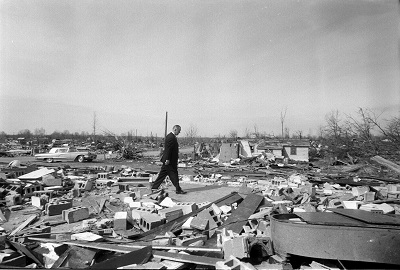Last updated: January 7, 2022
Lesson Plan
LBJ and the Environment of the 1960s

- Grade Level:
- High School: Ninth Grade through Twelfth Grade
- Subject:
- Social Studies
- Lesson Duration:
- 60 Minutes
- Common Core Standards:
- 9-10.RH.2, 11-12.RH.1, 11-12.RH.2, 11-12.RH.3, 11-12.RH.7
- State Standards:
- Texas Essential Knowledge and Skills for Social Studies: SS.17.D.9-12; SS.9.G.9-12; SS.28.A.9-12.
- Additional Standards:
- National Standards: D2.His.4.9-12; D2.His.12.9-12.
- Thinking Skills:
- Understanding: Understand the main idea of material heard, viewed, or read. Interpret or summarize the ideas in own words. Analyzing: Break down a concept or idea into parts and show the relationships among the parts.
Essential Question
What are the lasting environmental impacts of Johnson’s “Great Society” legislation?
Objective
During this lesson plan students will identify important legislation passed by President Lyndon B. Johnson to encourage revitalization and conservation of the environment. In addition, students will analyze primary sources to understand environmental issues of the 1960s. Finally, students will determine the overall impact of environmental initiatives created by President Johnson and how they relate to present-day environmental issues.
Background
This lesson plan serves as an introduction to President Lyndon B. Johnson’s Great Society initiatives, in relevance to environmental improvement, conservation, and revitalization.
Coming from humble rural beginnings, Lyndon B. Johnson’s upbringing shaped his political opinions and created a burning desire to positively impact the environment. His experiences with having a father as a state legislator, being a schoolteacher for underrepresented communities, and serving as director of the National Youth Administration of the State of Texas played pivotal roles in how Johnson viewed society.
LBJ came to the presidency as the nation was dealing with social issues such as discrimination, segregation, poverty. The United States also began dealing with a new, unique issue: the environment. The United States saw immense economic growth and development through industrialization and expansion. With an emphasis on technological advancements, very little attention was given to the impact the exploitation of resources would have on nature. Low-income communities were disproportionately affected by air and water pollution, being in close vicinity to coal and natural gas plants that caused a variety of health-related issues. Government mediation was desperately needed.
Thus, President Johnson had a personal responsibility to make long-lasting environmental and social change through direct governmental intervention. This came in the form of a movement called the Great Society. Through this campaign, LBJ demanded an end to poverty and racial injustice, which would come through emphasizing education and tolerance. He sought to prevent an “ugly America” by combating poor food, air, and water quality because of pollution, deforestation, and more. Through both programming and cooperation with local communities, President Johnson worked towards building a society where “the demands of morality, and the needs of the spirit, [could] be realized in the life of the nation.”
Preparation
To prepare for this lesson, please review Lyndon B. Johnson and the Environment park brochure.
Materials
Use this worksheet to review and analyze "LBJ and the Environment of the 1960s" video.
Download Video Analysis Worksheet
Use this worksheet to review and analyze the Water Quality Act of 1965.
Download Document Analysis Worksheet
Take a look at the political cartoon and analyze it. Document courtesy of Cleveland State University Library Special Collections.
Utilize worksheet to review and analyze the political cartoon. Worksheet courtesy of Library of Congress.
Download Political Cartoons Analysis Worksheet
Lesson Hook/Preview
This lesson plan serves as an introduction to President Lyndon B. Johnson’s Great Society initiatives, in relevance to environmental improvement, conservation, and revitalization. During this lesson, students will watch a video and answer question to explore the impact of President Johnson’s environmental policies. In addition, students will use primary and secondary sources to further understand the environmental issues from the 1960s.
Procedure
Activity A: Video Analysis
#1. Show video "LBJ and the Environment of the 1960s" and ask students to take notes.
#2. After video, have students complete Video Analysis Worksheet.
* Educators can stop at Activity A. To further understand the environmental issues of the 1960s, educators can continue with Activity B & C.
Activity B: Primary Document Analysis
#1. Have students read "Water Quality Act (1965)" document and analyze it by completing the Document Analysis Worksheet.
#2. After completing the Document Analysis Worsheet, post the following question to the entire class to have a group discussion: After reading this bill, explain what its significance? What are some of the notable aspects of the bill?
Activity C: Political Cartoon Analysis
#1. Students will review the political cartoon and complete the Political Cartoon Analysis Worksheet.
Vocabulary
Environmental Justice: Social Movement seeking to adress the inequitable distribution of environmental hazards among the poor and minorities.
Pollution: Pollution occurs when an amount of any substance or any form of energy is put into the environment at a rate faster than it can be dispersed or safely stored. The term pollution can refer to both artificial and natural materials that are created, consumed, and discarded in an unsustainable manner.
Civil Rights: Civil rights are an essential component of democracy. They’re guarantees of equal social opportunities and protection under the law, regardless of race, religion, or other characteristics.
Global Warming: An increase in the earth's atmospheric and oceanic temperatures widely predicted to occur due to an increase in the greenhouse effect resulting especially from pollution.
Bill: A draft of a law presented to a legislature for enactment.
Assessment Materials
Reflection and DialogueStudents will reflect on lesson plan assignments and complete the following questions.
Individually or as a group, students will answer:
-
What are some environmental issues that you notice today? Do any of these issues affect your community directly? Explain.
-
How do you think the environmental issues of the 1960s connect to the broader discussion of the Civil Rights Movement?
-
Who has the responsibility to protect our natural resources?
-
What is one idea that you have taken away from today’s lesson?
